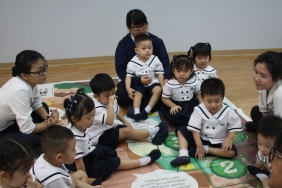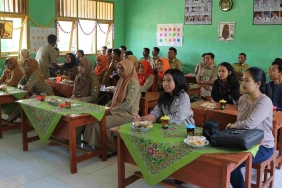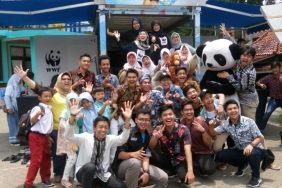SCHOOL MARKET, A SMALL PATH TO LOCAL FOOD SOVEREIGNTY
Five boys and girls jumped right and left as if to the beat of the music. They wear a long cloth wrapped around their bodies and a piece of cloth around their necks. These Suku Anak Dalam children attend Mandelang Remote Classroom, part of the One Roof Elementary School with SDN 067/VII Muara Sekalo located in Muara Sekalo Village, Sumay Sub-district, Tebo District, Jambi Province. The sound of gurgling water and chirping birds echoed from the loudspeakers installed, creating an atmosphere that was one with nature. The dance they performed at the opening of the School Market is a traditional creation dance of Suku Anak Dalam that tells the story of their daily life playing in nature, working together, and interacting with the forest as a source of life.
Children living in villages around Bukit Tigapuluh National Park, Jamb and Riau provinces, have several things in common. They grow up in an environment that is close to nature, especially forests. Nature becomes their space and source of play. Indeed, they are intertwined with the clear flowing river and the sound of the forest. The School Market is a place for children to recognize local culture and food that has been passed down from generation to generation. In Muaro Sekalo Village, Sumay District, Tebo Regency, Jambi Province, some traditional games have begun to disappear and be forgotten. However, diversity and unity become an inseparable cultural identity.
In addition, this activity also introduces various cultures and local wisdom that are still sustainable in Muara Sekalo Village, such as silat pangian martial arts, traditional klentang musical instruments, and weaving culture. To instill these cultural values, the school works closely with parents to keep the children connected to the traditions that have been passed down from generation to generation. Parents' enthusiasm in supporting this activity is very high. Azizah, one of the parents of Grade 1 students, expressed her pride that the children could be involved in an educational and local culture-based activity. "Children learn many things, not only selling goods but also how to appreciate the crops they grow themselves", she said.
From School Garden to School Market
At the School Market, various products from the school garden are sold, such as ginger, turmeric, and kencur. Putri Wira Agustin and Karisa, 4th-grade students, enthusiastically explained their harvests that were processed into various ready-to-sell products. "We grow ginger and turmeric in the school garden, then process them into herbal drinks with brown sugar," they said.
Helen, one of the grade 4 teachers from SDN 067 Muara Sekalo added that this activity is integrated with Environmental Education (EE) subjects. "The school has a living pharmacy, so before the School Market, the children were already used to planting and caring for medicinal plants. They learn about their health benefits and how to process them to make them more economically valuable," she explained.
In addition to selling school garden produce, many students also bring garden produce from their homes. For example, turmeric is often used in traditional medicine." Here turmeric is known as temasan medicine, which is a term for turmeric that is grated and then read a prayer by a shaman before being applied to a sick person. Temasan is also used for mothers who have miscarried or as a drink for mothers who have just given birth. "Turmeric is grated, then the juice is drunk with a mixture of brown sugar," said Helen.
There is also a hereditary belief that turmeric originated from the umbilical cord of Siti Fatimah, the daughter of the Prophet Muhammad. This myth adds historical and spiritual value to the community in utilizing turmeric as a natural medicine.
In addition to spices, various types of local plants such as rumbai leaves, and forest pandanus are also introduced to students. These plants are commonly found in the village environment, especially around rivers and swamps. The pandanus will be woven by the women to make mats and to mark when they are ready to get married. Weaving is not only a traditional craft but also a cultural symbol of marriage in villages along the Bukit Tigapuluh landscape.
Transmitting Change to the Village
The noisy voices of 4th-grade students fill the school garden. They are harvesting medicinal plants that they have been tending for the past six months. Demand from Muara Sekalo villagers continues to increase. They buy the harvest from the school garden to replant in their backyards.
The spirit of farming is contagious, which was initially only carried out by students in the school garden, then residents also planted in their yards. Helen, a teacher at SDN 067/VIII Muara Sekalo, sees this change as having an impact on the community's awareness of utilizing yard space to grow vegetables and medicines.
"Previously, people did not utilize their yards to the fullest. They thought that planting could only be done in the garden. However, after seeing the enthusiasm for selling ginger, kencur, and turmeric, parents began to buy them not only for consumption but also for replanting in their yards," he said.
The collaboration between schools and parents in introducing the benefits of these plants further strengthens children's attachment to their local culture. Muara Sekalo Village Head, Suherman, fully supports this program as a form of collaboration between various parties in addressing food security issues in the village. "We thank WWF-Indonesia for establishing the Joint School-Based Community Forum. This program proves that schools can be a place of learning that not only teaches academic knowledge but also provides education to students to grow crops so that students understand the process of growing plants so that they can foster a sense of belonging to nature, where nature is also a source of food," he said. According to Sarjoni, schools must prepare children as early as possible to become the next generation who are independent and able to preserve local culture. "We want children to not only have academic skills but also have cultural knowledge and life skills that will be useful for them in the future. That way, they can continue their education to a higher level and help break the dropout chain that is still a challenge in this village", he explained.
School Market activities are also a moment for children to deepen their understanding of Local Content (Mulok) and Environmental Education (PLH) lessons, which have been taught since 2019. The program invites students to understand that local food is not just a source of nutrition, but also part of a cultural identity that must be preserved.
WWF-Indonesia mentioned that the School Market initiative began with the formation of the Joint School-Based Community Forum in Muara Sekalo. This forum aims to increase collective awareness of shared responsibility in supporting the development of education in schools and facing challenges, especially environmental issues that can affect the teaching and learning process of early childhood. The forum involves the active participation of the Village Government, community leaders, youth leaders, women leaders, parents of students, as well as the school, including principals and teachers.
Nazli Herimsyah, Coordinator and Project Executant of WWF-Indonesia's Bukit Tigapuluh Landscape said that this initiative is a good step in finding joint solutions to the constraints and challenges faced by the village with a solution-based school approach.
"The background of this School Market initiation is to achieve food security as one of the sustainable development goals. The phenomenon of household leakage is also the basis for the formation of this activity. The people of Muara Sekalo Village should be able to produce their own food such as vegetables, fruits, and even proteins such as fish and chicken. However, at present, almost all of these foodstuffs are supplied from outside at high prices due to transportation costs, which in turn significantly increases people's expenses," he explained.
Through the School Market, children in Muara Sekalo Village not only learn to trade, but also understand the importance of food independence, cooperation, and cultural preservation. This activity is a clear example of how schools can become learning centers that not only teach academic knowledge but also build awareness of the importance of maintaining ancestral heritage. A small step towards food sovereignty rooted in cultural values and togetherness.
,>





